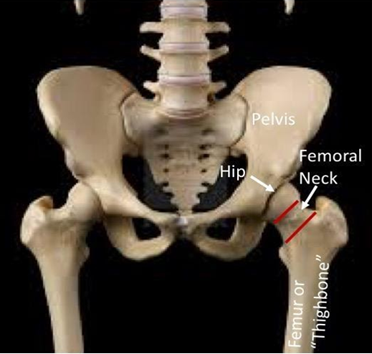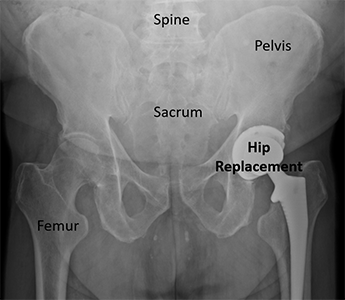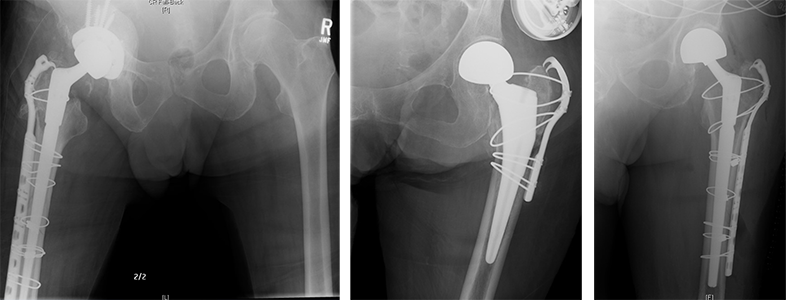Basic Anatomy
Your hip joint is made up of two bones. The top of your femur, or "thighbone," and your pelvis, or "hip socket." Your hip is a ball-in-socket joint that allows you to move the top of your leg when walking. You may know someone who has had a hip replacement after his or her hip socket wore out from arthritis. A hip replacement involves removing the top of the femur by making a cut at the femoral neck. The top of the femur and the socket are replaced with metal and plastic.
Mechanism and Epidemiology
A periprosthetic hip fracture is a broken bone that happens around or very close to the implants (metal and plastic) of a hip replacement. This broken bone can happen during the surgery to replace the hip or from a fall or other trauma. The fracture typically occurs in the thighbone around the metal stem. The bone around the hip socket can also break but this is less common.
Initial Treatment
If you have a periprosthetic hip fracture, they are generally quite painful, and prevent standing or walking because it is too painful to do so. Any motion of your injured hip will result in pain. If you have one of these fractures, you will need to be taken to an emergency room. The blood supply and nerve function of your injured leg will be checked. X-rays of your hip and thighbone as well as a CT scan may be done. You may need to be admitted to the hospital or transferred to another hospital that takes care of this type of injury. Other tests and scans of your head and heart may be done to see if anything else was injured.
General Treatment
This type of fracture typically requires surgery. The type of operation depends on many factors including if the stem (implant) is stable in the thighbone or if it is loose. The location of the broken bone is also an important factor. If the implants remain attached to the bone, a plate, screws, and wires will be used to fix the bone. If the implants are loose, the old implant will need to be replaced by a new one. Plates, screws, and wires may also be added.
Postoperative Care
After surgery, you will work with physical therapists in and out of the hospital to rebuild your strength and walking ability. The amount of weight that you can place on your injured leg depends on a number of factors, and will be decided by your surgeon. Typically, you will get a blood thinner after surgery to prevent blood clots. Blood thinners and early movement are important to minimize the chance of getting a blood clot. Several different types of pain medication are typically given for post-operative pain including acetaminophen (e.g. Tylenol), anti-inflammatories, and a narcotic for breakthrough pain.
You may also need to limit movement of your leg after surgery to try to prevent a dislocation of your hip joint. Braces may also be used for this reason.
You will likely be discharged after a short stay in the hospital, and may need to spend some time in a rehabilitation facility. You will return to see the operating surgeon in the first few weeks after surgery. It is very important that you follow the instructions of your surgeon.
Long Term
After surgery, you will generally require an assistive device such as a walker or cane to help you walk. This may be temporary or permanent. Physical therapy is usually needed to get back to as much normal walking as possible. A physical therapist will work with you on motion, strengthening, stretching, and endurance training. To make your recovery process as fast as possible, it is important for you to do the exercises you learn in therapy at home as well.
Complications after a periprosthetic hip fracture can occur. These include blood clots, infections, difficulty walking, a limp, hip dislocation, and unequal leg lengths. You may need further surgery, antibiotics, hospital stays, and/or braces to treat these complications.
Lance Jacobsen, MD
All x-rays and pictures taken from the personal collections of Dr. Jacobsen and Christopher Domes, MD




